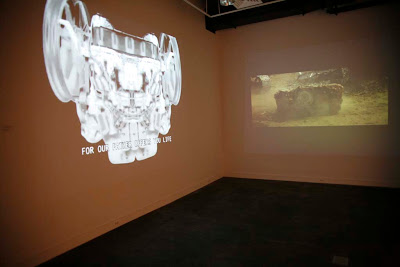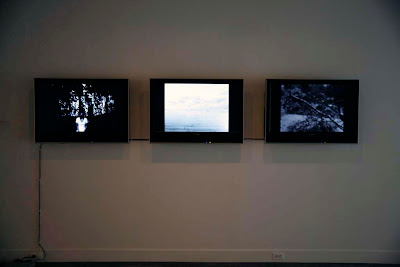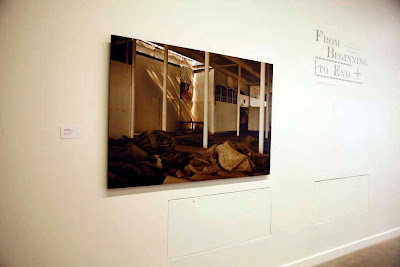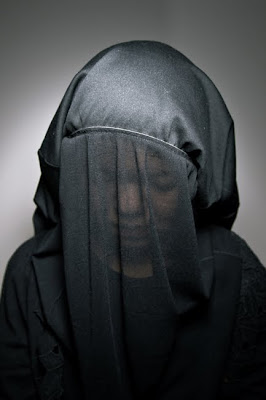


Our lives are inextricably linked. The artists in this exhibition explore birth, life, and death in different ways, all attempting to understand their own relationship with the world.
Our lives have a beginning and end whether we believe it is predetermined or by chance, we all experience our world in different ways. Some believe that personal stories and memories are what define our lives. Some fixate on illness and our progression towards death while others take comfort in the fact that they are part of a cycle that is ongoing. Even though we look at life differently we will experience birth and new beginnings as well as mourn the loss of someone close.
This exhibition asks the viewer to reflect on and question their own personal feelings about life and death, and leave with a deeper understanding of their own mortality.
Peter Barbor, Ceramics BFA 2010
Actaeon


Actaeon is the central figure in an ancient Greek myth. A hunter who accidentally happens upon the virgin goddess Diana bathing in the woods, he is transformed into a stag and ripped limb from limb by his hounds as punishment for the transgression of viewing her unclothed body. As the hunter becomes the hunted, Actaeon dies as a direct result of the innocent sin of his sexuality. In this reiteration of the ancient story, Actaeon’s tragedy is embodied in the brittleness and fragility of bisqued and unfired clay. Helplessly suspended off the ground, Actaeon is reduced to the husk of a man, frozen in the futility of his transformation, both a man and a monster.
Perilin


Imagine a future world of sprouting, fruiting plant matter, bursting forth from quiet gardens, and bringing chaos to ordered museums. This is a world where nature is reclaiming her place in the world by creeping over roads, vehicles, even our great works of art in a slow whimsical dance. This wild floral growth subverts a previous state of normalcy, creating something preternatural from this transformation. Rich placid greens, angry neon pinks, dark bruised purples and electric yellows flow over the curves and undulations of this insidious growth. Saturated colors embrace the three-dimensionality and tactile qualities of the ceramic surface, a realistic palate is unnecessary; color is used instead to translate human mood and emotion to clay and the painted surface.
In her recent studio work Jessica Riva Cooper has been exploring the parasitic and insidious nature of plants and fungus such as the Cordyceps Fungus and the Kudzu vine. Some Cordyceps species are able to affect the behavior of their insect host. The Cordyceps unilateralis, for instance, causes ants to climb a plant and attach there before they die, assuring maximal distribution of the spores from the fruiting body that sprouts out of the dead insect's body. The Kudzu vine has proliferated the Southern United States, similar to other vining plants that are slowly reclaiming the thousands of abandoned houses throughout America. In Detroit alone there are over ten thousand abandoned houses and any time. These houses become ‘feral’, disappearing behind ivy and trees that were planted generations ago.
Patrick Egger, Printmaking MFA 2010
Camping in Canyonlands, Utah… It’s Raining Babies. 1:29 a.m. July 5th 2138
Born Again Bird

Drawing and portraiture are the primary interests of Patrick Eggers’ work. He uses these long-established methods to reinvigorate not only the question and purpose of drawing, but also as a way to explore our culture today. Camping in Canyonlands, Utah… It’s Raining Babies. 1:29 a.m. July 5th 2138 imagines a society very changed in the future, where overpopulation leads to a storm of babies falling from the sky. In the piece Born Again Bird, Egger explores the idea of rebirth through his character who imagines what it would be like to be reborn a bird.
Mary Gagne, Textiles MFA 2010
Mourning Fabric

This piece was conceived of in direct response to modern society’s lack of a visual symbol telling of one’s grief. In our eagerness as a collective to embrace new lifestyles, ideas and technologies, we have abandoned some very useful traditions. For example, today the widow no longer wears black.
So then what do we do to represent our grief, to explain to the passing stranger, neighbor, friend or colleague, that we are sad and to please be patient, understanding the empathetic?
To this void Mary Gagne created her own personal symbol specific to her own experiences of life and loss. She knitted a cloth that melds visual elements of color and pattern inspired by the mourning traditions from an array of cultures.
Interpreting one particular tradition of cutting a piece of one’s own clothing upon hearing the news of a loved one’s death, Gagne will unravel what she has created. Over time, as each day passes, she will unravel a little of this cloth. She hopes to unravel her grief until the memory of the loss exists no more.
Martin Goebel, Furniture MFA 2010
Fusion Day Bed

Siberian Elm trees were introduced into the United States in the late 1800's. In its indigenous Northern Asia the Siberian Elm is a small and slow growing tree due to the short growing season and poor soil quality. When introduced into the favorable climate and nutrient rich soil of the central United States the trees flourished. In the favorable climate the trees can reach diameters of 3 feet or greater and heights of 150 feet. The root systems of these trees were never genetically intended to hold the stresses put on them by such mass above. In the peak of summer while the tree is in full leaf, straight line winds which are precursors to Tornados reach speeds upwards of 60 miles an hour. These winds catch the Siberian Elms like parachutes and pull them out of the ground leaving pristine tree trunks perfect for furniture. Martin Goebel harvested the lumber from a tree in Saint Louis, Missouri, a tree that would have otherwise been split for firewood or ended up in a landfill. The piece is asymmetrical with an organic and a geometric side. The raw form (in which all wood starts yet we rarely see) is highlighted rather than sawn off and cast aside. Notice the grain patterns/selection as it transitions from free form to linear as the design transitions from organic to geometric.
Cooper Holoweski, Printmaking MFA 2009
Alpha and Omega
Lazarus Machine

Growing up in Detroit, Michigan Cooper Holoweski has come to see the automobile engine as more than a utility for getting us from point A to point B. This complex machine of gears is an organism with a metabolism and independent destiny. The automobile engine represents a human, it represents a global economic system, it represents an inescapable closed circuit into which we have placed our faith.
Naomi Mishkin, Glass BFA 2011
Inside

In Inside, Naomi Mishkin explores the concept of dissection and internal investigation. She seeks to question our idea of our understanding of our own bodies. Illustrating a
17th century diagram of a woman’s uterus in successive layers of glass, she frames this seemingly basic and intuitive diagram in the context of a modern biology textbook.
Peter Pa, Film, Animation, Video, BFA 2011
Tryptic

This triptych explores what humans and other living things do when in the period of birth, life, & death. In the midst of these three stages, they have a choice on how to react. So, birth, life & death can either be a positive moment or negative one.
Decalogue of the Artist
I. You shall love beauty, which is the shadow of God over the Universe.
II. There is no godless art. Although you love not the
Creator, you shall bear witness to Him creating His likeness.
III. You shall create beauty not to excite the senses but to give sustenance to the soul.
IV. You shall never use beauty as a pretext for luxury and vanity but as a spiritual devotion.
V. You shall not seek beauty at carnival or fair or offer your work there, for beauty is virginal and is not to be found at carnival or fair.
VI. Beauty shall rise from your heart in song, and you shall be the first to be purified.
VII. The beauty you create shall be known as compassion and shall console the hearts of men.
VIII. You shall bring forth your work as a mother brings forth her child: out of the blood of your heart.
IX. Beauty shall not be an opiate that puts you to sleep but a strong wine that fires you to action, for if you fail to be a true man or a true woman, you will fail to be an artist.
X. Each act of creation shall leave you humble, for it is never as great as your dream and always inferior to that most marvelous dream of God which is Nature.
Ki Ho Park, Photography MFA 2010
Closed


The evidence of closed stores has a poetic trace of business suddenly gone, left in a hurry. I pear through the window to see what is left behind: empty tables and chairs are exposed, and the blooms and trash cans sit in the corners. The empty stores are sitting in vain desperately looking to find a new occupancy. But, unfortunately, the waiting is far longer than anyone expected. And these vacant buildings are slowly showing a sign of decay and creating “a dying urban landscapes.” Time magazine states, “The Great Recession is transforming how we spend, whom we trust, where we save and what we really value.” These changes are long overdue. Ki Ho Park is an investigator, examining the debris left behind to find out what existed before and collecting the data that can foresee the current crisis. The evidence is fresh and unmarked; he records it before it is bulldozed to dust.
Charlotte Potter, Glass MFA 2010
The Laboratory


Six workers in long white laboratory coats, all focused on their task. The woman in the foreground is focused on removing the dead butterflies from a glass stomach that resembles alchemy apparatus and placing them into a safe on a shelf. She carefully inspects and catalogues these specimens, putting them into small envelopes as if evidence of an experiment. Another woman steadily rides a stationary bike that rotates an hourglass filled with oil and water; she seems to be trying to emulsify these desperate liquids while referencing the passing of time. Twins stand next to each other held at attention in glass prosthetic stands. One of each of their eyes is being recorded by a video camera and projected together onto the wall in front of them to create a single set of eyes. Here the two become one identity, however the eyes wander off in different directions, making the one implied face at odds with itself. A woman and a man stand facing each other wearing glass oxygen masks attached with a glass tube, suspended in a tenuous balance. The glass mask fills with their condensation as they breathe in this closed system. This relationship seems at once poetic and toxic as they recycle each other’s breath and consume one another. The room seems to be filled with contradictions. The eyes look different directions, these careful experiments are packed into a congested small space, the scientific is being turned into myth.
This piece is an exploration into relationships; failed, dysfunctional, attempted, forced, genetic. Each performer is playing out one of these roles via different metaphors that the onlooker is left to decipher on their own. The tone is indifferent; each performer seems to be doing an experiment, as would a worker in a lab who is testing hypothesis. Some are testing, while others clean up the residue of a former project that has come to an end.
Allison Sloan Roberts, Printmaking MFA 2009, Museum Education 2011
Saccade Saccade

Allison Sloan Roberts’ haunting images are photographs of an illusion, of a photograph of a recreation, of a fiction on film. Her work investigates fear and death. In Saccade Saccade, Roberts explores the effect classic horror films have had on our understanding of death.
Rui Sasaki, Glass MFA 2010
Memories

Glass is transparent, sometimes unseen and sometimes seen. "Transparent" is invisible to the eyes but is also inexplicably dense. When Rui Sasake makes the "Transparent" visible she magnifies the sense of smell, hearing and touch so she can better perceive what happens in the world.
The dirt ball is made by her hand. 100 percent is dirt. It is just the size of her hand. She follows her childhood memory from kindergarten of how to make the shiny dirt ball. Her childhood memory is related to and based on her senses of smell, taste, touch, sound and sight, which are vital in her life. Making the dirt ball is one of the most repressed memories of her childhood. She does not have any memories in the US, which is an extreme situation for her. Memories construct her life and body. She cannot survive if she does not have memory at all. Making the shiny dirt ball is an "exercise" to remember her memory and to sustain her life. A dirt ball becomes her life as an object.
Rose Simpson, Ceramics MFA 2011
Jess Riva Cooper, Ceramics MFA 2010
Fonda Yoshimoto, and Ceramics MFA 2010
Ceremony


In the pueblo southwest, the tradition of Bpeni-we Geh honors the dead. The belief is that the deceased will continue to need sustenance in the afterlife, however food must be delivered to the dead in a very specific way. A pot is made with care and contemplation for the deceased loved one, and left unfired. Food is collected and placed within this vessel and broken, allowing both food and vessel to travel to the other side, the afterlife.
This installation is inspired by the Bpeni-we Geh traditions. Simpson, Cooper, and Yoshimoto will use clay to make small vessels as part of a daily ritual, continually adding to the installation. These simple objects are made with reverence, in contemplation of a loved one who has passed, or to support someone else who has suffered a loss.
Laura Swanson, Digital + Media MFA 2011
Thayle & Laura and Young Americans

Veil

Laura Swanson has a strong attraction towards iconic images, specifically political, religious and court portraiture of kings and queens. By inserting members of her family and herself in these roles, she is concerned with the likelihood that the viewer's perceptions about portraiture changes - especially with regard to the implied relationship of subjects in diptychs. What is her relationship to the figures she is placed next to? Is it a surprise for the viewer to find out that they are loved ones of hers? Why is it so surprising?
Lauren Tickle, Jewelry & Metalsmithing MFA 2009
WEATHERED

I think weathered means to have survived, as in weathered the storm. If someone is weathered they have survived the storms of their life and they have the marks to show it. – Aliza Schiff
To show visible signs of experiencing something challenging – Jane-Marie Ovanin
Something that has been around for a long time
Someone has lived a long time so the newness is gone and you start to look old – Judy Geurts
Organic decay sustained over a long period – William Russell
Physical manifestation of how hard the body has worked over a lifetime –Heather Lee
Life-altering experiences have been witnessed. Innocence is gone. – Lauren Tickle
Record of incremental change left on the built environment by its inhabitants. -Jonathan M. Olly
Old and faded due to exposure both physically and emotionally by life experiences, relationships, and or hard labor. –Max
Someone who has lived and experienced life… someone who is worn with age. –Meinda Byam
Experience and meaning, wisdom in experience - Alissa Wassung
Anna Ullman, Printmaking BFA 2010
Self Portrait

Scars are permanent marks that people have to deal with for their whole lives. Scars shape who a person is, and therefore can be the most interesting things about a person. Anna Ullman loves the idea of documentation on a body. The theme of scars, whether superficial or emotional, has played an influential role in her work. This self-portrait is very personal. It exposes the most difficult obstacle that she has ever faced and at the same time has made her the person she is today. These prints are about her life and how it may have been a bit different from yours.
In the 5th grade Anna Ullman was diagnosed with a serious case of scoliosis. Because she was too young for major surgery, she was placed in a brace as an alternative. Ullman is only her true height (5’ 2”) when she wears her back brace. It is a scar that she was born with and will have to deal with for the rest of her life. The two three-color, full-scale wood relief prints are meant to resemble antique anatomy posters. There is an uncomfortable stiffness to old anatomy posters that mimic the way she felt having to be placed in a back brace. The brace itself is represented as an ironic void, yet one can still understand the amount of pressure that is being inflicted on the body.
Heath Ballowe, Printmaking MFA 2010
Fonda Yoshimoto, Ceramics MFA 2010
Immortality Through Regeneration


Heath Ballowe and Fonda Yoshimoto both use memory as a starting point in their work. In Immortality Through Regeneration, the idea of memory carries over as they explore the impressions we leave behind as we live our lives. Our impressions can be permanent or ephemeral and are evidence of where we have been and where we are going. At first glance the piece appears to be an open sarcophagus, but upon closer examination, the interior space contains the earth inside with the impressions of two bodies with the life masks of the artists. One can imagine the body sinking into the earth leaving this marking behind. This container is representative of more than death as the human form becomes a place for something to grow and transform into something living. The permanence of the life masks slowly becomes obscured, swallowed into the earth over time.